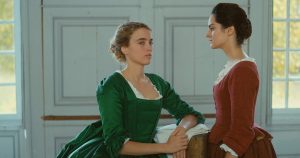M, 119 minutes
5 Stars
Review by © Jane Freebury
A boat with a young female passenger on board makes its way along a rocky coastline. When a piece of luggage falls overboard she jumps in to rescue it, petticoats, boots and all. It might have been end of story in late eighteenth-century France where this film is set but, surprisingly, she can swim.
Artist Marianne (Noemie Merlant) is on her way to take up a new commission, painting the portrait of a young aristocrat who lives in a chateau on an island off Brittany. The new client, the Countess (Valeria Golino), needs a likeness of her daughter Heloise (Adele Haenel) to send to a prospective husband, a Milanese nobleman, so the wedding can go ahead.
An arranged marriage in times past, stirring scenes on a beautiful, empty beach, a woman who expresses herself in the arts. It’s not possible to watch this ravishing period piece without thinking of Jane Campion’s The Piano. But there are significant differences. This is a love story between two women, and as the filmmaker points out, they are equals.it's not possible to watch this ravishing period piece without thinking of The Piano, but there are significant differences
 |
| Correcting the pose: Heloise (Adele Haenel) on left and Marianne (Merlant) |
It seems to me no accident that the writer-director, Celine Sciamma has set her story before the onset of the French Revolution, at a liminal moment for freedom and equality. She makes nothing of it, however.
Heloise, just out of a convent is refusing to marry, and she won’t cooperate for any portrait because the result will be marriage. Marianne learns that her elder sister didn’t wish to marry the Milanese nobleman either, and it seems she took her life on a walk along the cliff edge.
With instructions from the Countess to become her daughter’s companion, Marianne spends her days observing Heloise and taking mental notes as they go on walks together. She then paints by candlelight in the evening.
With little else to do but walk, talk and read, a relationship begins to develop between the artist and the aristocrat. In particular, they love to read and re-read the myth of Orpheus and Eurydice, wondering about the motivations behind the tragic ending.
Although Heloise becomes aware of the deception she agrees to be painted anyway and during the sittings the two women spar, circle each other and eventually fall in love. The scenes as their relationship develops are exquisitely written by Sciamma, who won best screenplay at Cannes.
We don't see much of men here. After Marianne's arrival at the isolated castle, they are scarcely present though they are still operating outside the frame. Like the Milanese nobleman directing events from afar, or the local swain who has made the diminutive maid, Sophie ( Luana Bajrami), pregnant.men are scarcely present, though still operating outside the frame
The absence of men allows Portrait to concentrate exclusively on a world of women in which the female sensibility and solidarity rules. It is expressed with intensity one evening when Marianne and Heloise join a group of local women gathering in the fields around a bonfire. It isn’t really clear what the gathering is about, but when the women join in an exquisite capella chorus and sing in Latin, it becomes a moment of surreal beauty and a celebration of feminine unity.
The painterly imagery is beautiful if rather stern and uncluttered and the soundtrack, with little music, is simply content to heighten the realism of the domestic world the women inhabit, with its crackling hearth and rustling, breathy silences. It is all the more powerful for it, more than making up for the minimalism with a few sublime musical moments like the ethereal capella singing.
On another occasion we hear ‘Summer’ from Vivaldi’s Four Seasons when Marianne bumbles through it on a harpsicord. She doesn’t do it justice, but the scene lays the foundation for the amazing and intense concert finale.
 |
| the sea plays its part: can Heloise (Adele Haenel) swim too? |
This intelligent and sensuous film is special. An intimate and delicate study of how two people can fall in love. Marianne and Heloise could be any two individuals who fall in love, and the world that their story builds is rich reward to those who are willing to enter.
First published in the Canberra Times on 29 December 2019. Also published on Jane's blog
